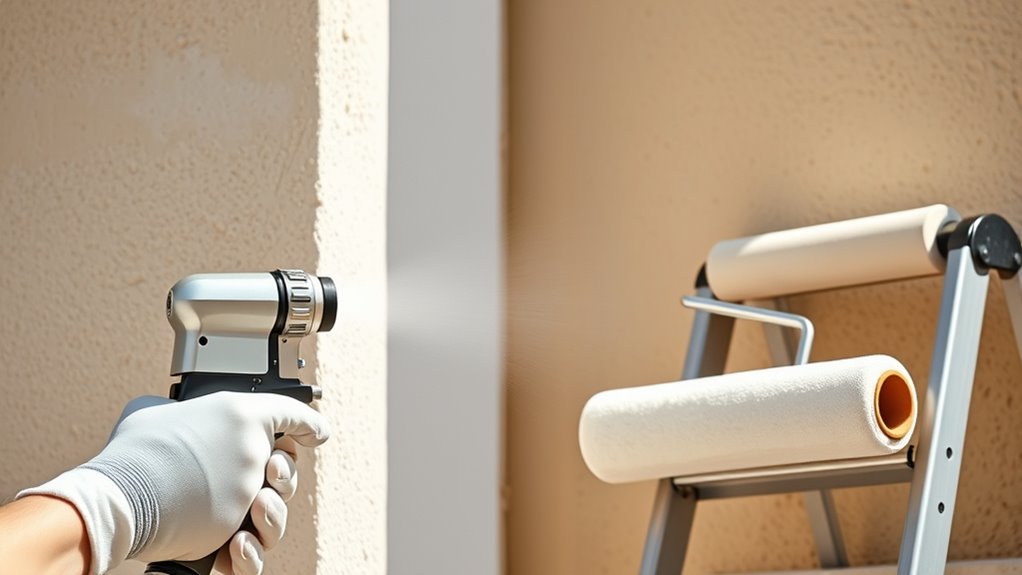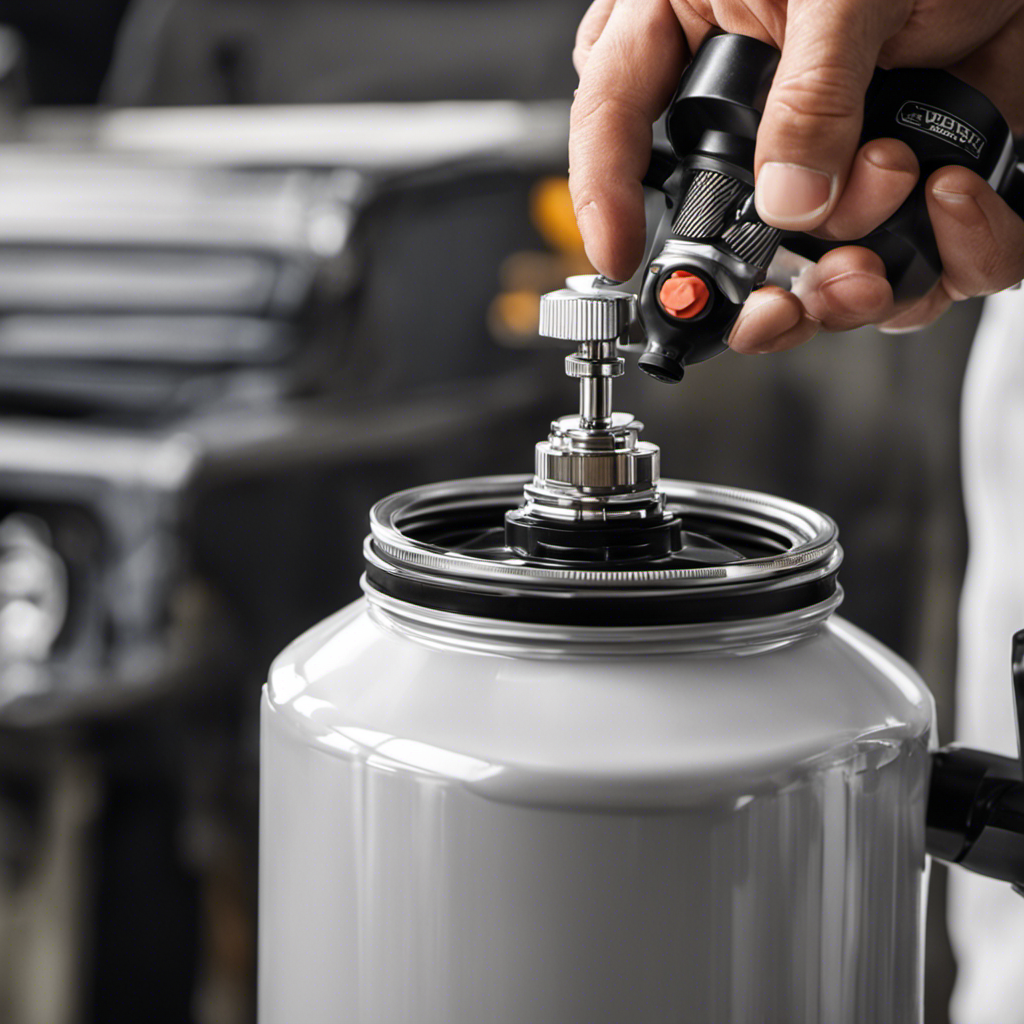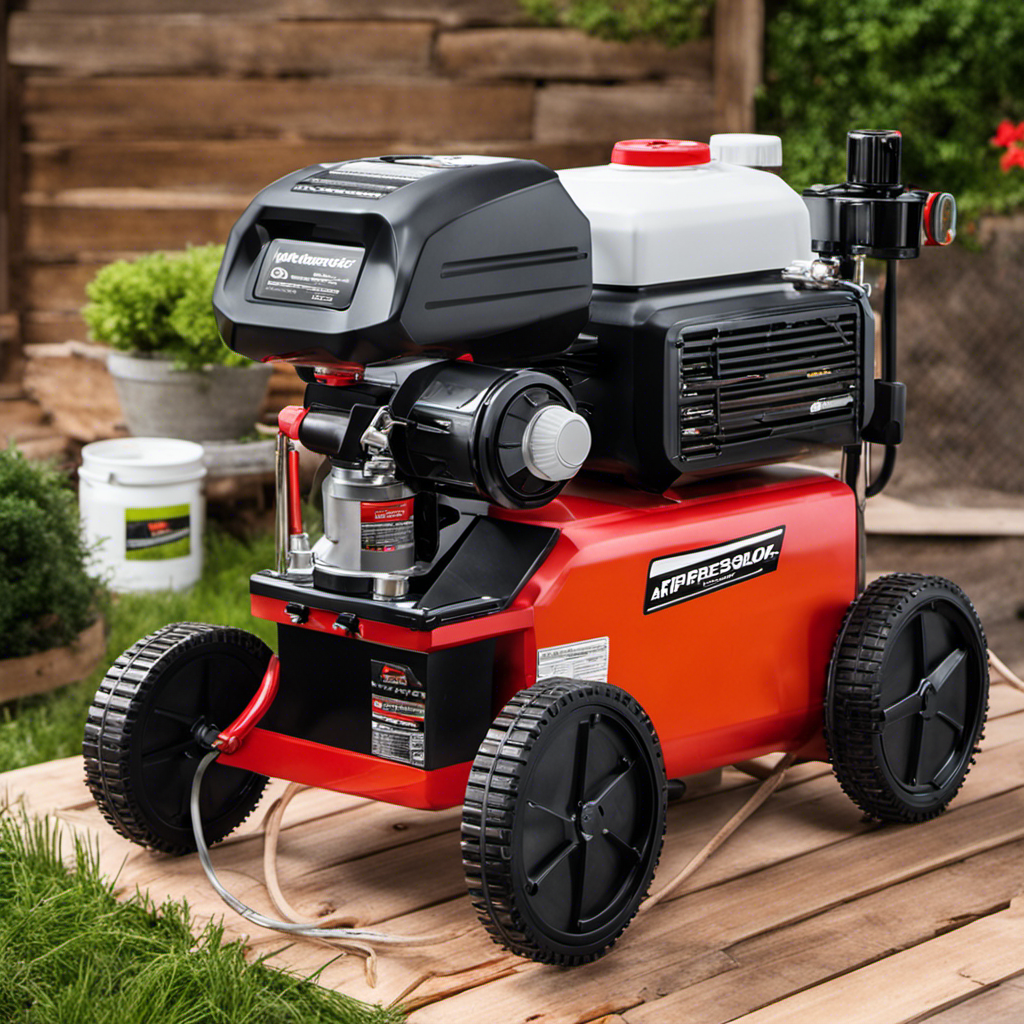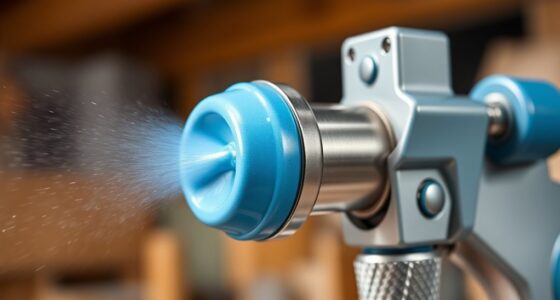Choosing between spraying or rolling exterior house paint depends on your surface type, project size, and desired finish. Spraying covers large areas quickly and works well on textured surfaces, but it requires more equipment and skill. Rolling offers precise, even coverage and is better for small or detailed areas. Consider your experience, budget, and the look you want. Keep exploring—more tips can help you decide which method is best for your home.
Key Takeaways
- Spray painting covers large areas quickly but requires steady control for even, adhesion-friendly results on textured surfaces.
- Rolling offers precise, uniform coverage and is ideal for detailed areas, corners, and trims.
- Consider surface texture, material, and project size; rough surfaces may benefit from rolling, while smooth surfaces suit spraying.
- Budget, time constraints, and experience influence method choice; spraying is faster but more costly, while rolling is more controllable.
- Proper preparation and technique ensure durability, regardless of method, reducing long-term maintenance needs.
Comparing Application Techniques: Spray vs. Roll

When choosing between spray and roller methods for exterior house paint, understanding their differences can help you make an informed decision. With spray applications, you’ll cover large areas quickly, but controlling the spray pattern requires steady brush techniques to ensure even coverage. Spray methods are excellent for textured surfaces, but they can pose challenges for paint adhesion in tight corners or delicate trims. Additionally, spray equipment can be more costly and requires proper maintenance and cleaning, which is essential to keep it functioning effectively. Rollers, on the other hand, allow you to work more precisely, using consistent brush techniques to achieve smooth, uniform coverage. They also help improve paint adhesion by pressing the paint into the surface, reducing the risk of missed spots. Both methods have their advantages, but knowing how each affects coverage and adhesion will guide you toward the best application for your exterior project. Additionally, choosing the appropriate application technique can reduce waste and optimize the longevity of your paint job, especially when considering factors like surface texture and detail work for better coverage.
Factors Influencing Your Choice of Painting Method
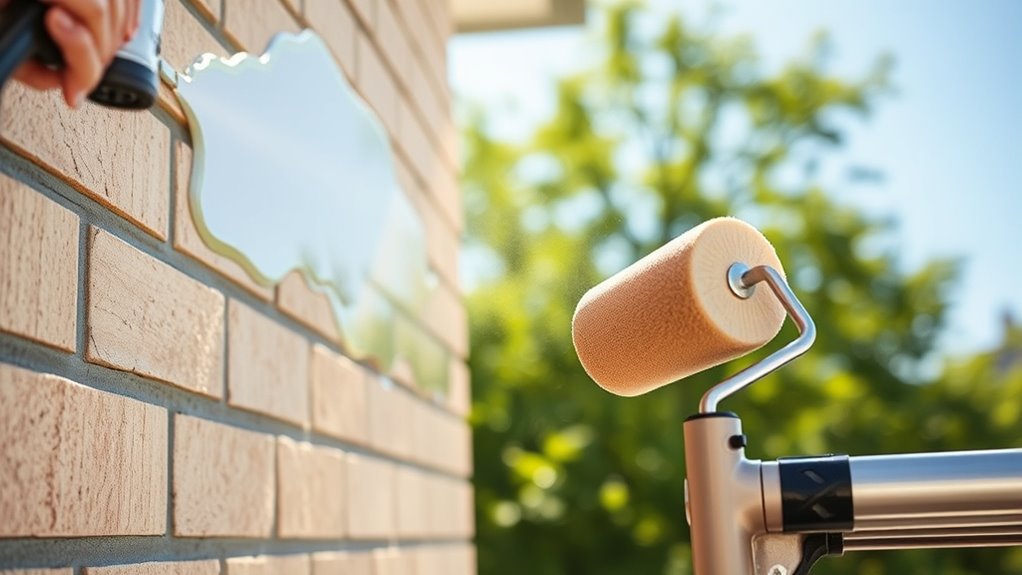
Choosing the right painting method depends on several practical factors that can influence your results. One key consideration is your brush techniques, which affect how well paint adheres and covers surfaces. If you prefer detailed, controlled application, brushing might be suitable, especially on tricky corners or trim. Paint compatibility also plays a role; some paints work better with sprayers, while others require rolling for even coverage. Surface texture and material impact your choice—rough surfaces may benefit from rolling, while smooth areas may be better suited for spraying or brushing. Additionally, your experience level matters—if you’re new to painting, brushing offers more control. Understanding how brush techniques and paint compatibility interact will help you select the most effective method for your exterior project. Moreover, considering Gold IRA options can be a wise long-term investment to safeguard your financial future beyond home improvement projects. Incorporating industry transformation trends, such as AI automation, can also streamline your painting process and improve efficiency. For example, advanced painting technology tools are making application methods more precise and less labor-intensive. Also, exploring innovative coating materials can enhance durability and ease of application, leading to better results. Additionally, understanding financial security options can provide valuable strategies for protecting your assets over the long term.
Cost and Time Considerations for Exterior Painting
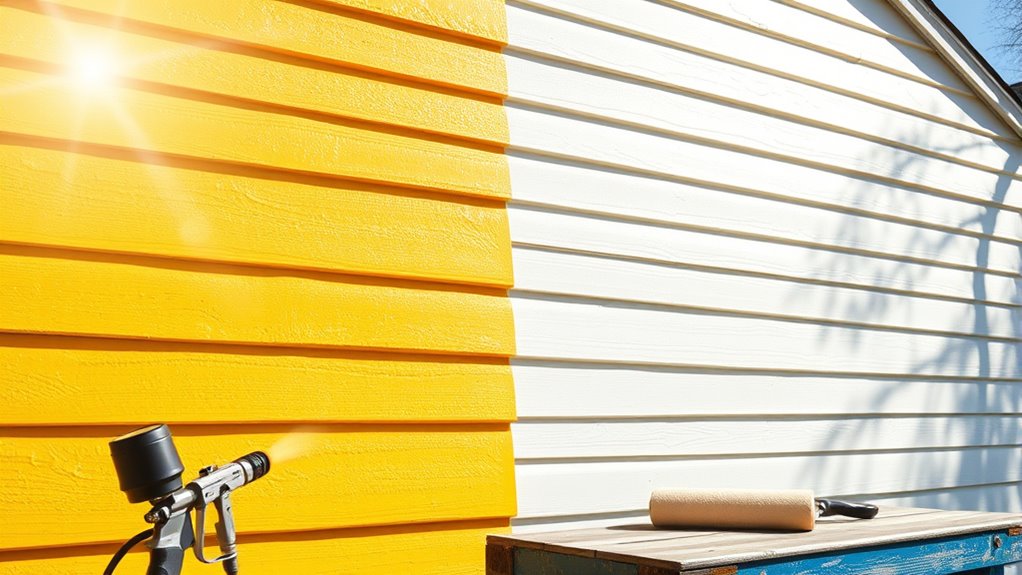
Cost and time are critical factors that can substantially influence whether you opt for spray or roll painting for your exterior. A thorough cost analysis helps determine which method fits your budget, considering equipment, paint, and labor costs. Spray painting usually requires more equipment and setup, potentially increasing expenses, but can save time on large surfaces. Weather impact is also significant; high humidity or rain can delay projects, especially with spray, which needs dry conditions. Rolling often takes longer but offers more control and flexibility in various weather. Consider these points:
- Equipment and material costs
- Project size and surface complexity
- Weather conditions and forecast
- Time needed to complete each method
- Potential weather delays affecting schedule
- Application techniques can also influence paint adhesion and durability, which are crucial for long-lasting exterior finishes. Balancing cost and time ensures an efficient, budget-friendly painting project.
Achieving a Professional Finish: Tips and Tricks

Achieving a professional finish on your exterior house paint requires attention to detail and proper technique. Start with brush techniques that ensure smooth, even coverage, especially on edges and tricky corners. Use long, consistent strokes to avoid streaks and maintain control. Pay close attention to paint consistency; it should be neither too thick nor too runny. Properly mixed paint helps prevent drips and uneven texture. When rolling or spraying, keep your tools loaded with an adequate amount of paint to avoid dry spots. Always work in manageable sections, overlapping slightly to blend areas seamlessly. Taking your time and follow these tips will result in a clean, professional-looking finish that enhances your home’s curb appeal. Additionally, maintaining proper painting environment conditions, such as temperature and humidity, can significantly influence the quality of your finish. Being aware of store hours, especially for supplies or professional assistance, can help you plan your painting project more effectively. Ensuring proper surface preparation is also crucial for achieving a smooth and durable coat. Incorporating the right application techniques can further improve your results and help you achieve a flawless appearance. To further improve your technique, consider assessing space and organization within your workspace to keep your tools and supplies easily accessible and prevent clutter that could impede your progress.
Maintenance and Longevity of Spray vs. Roll Coatings
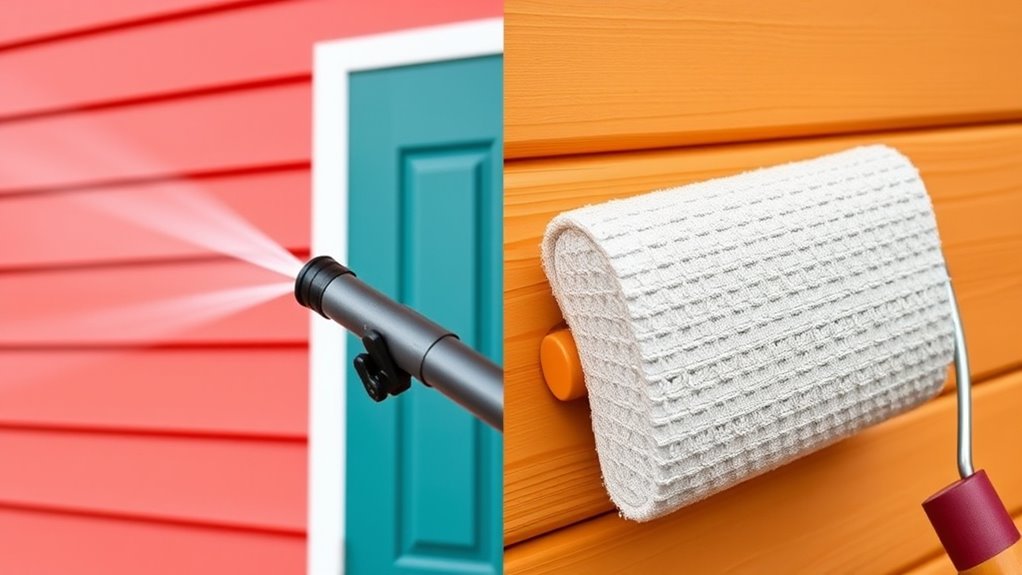
While both spray and roller coatings can last for years with proper care, their maintenance needs and durability vary. Spray coatings often require less frequent touch-ups but demand meticulous surface preparation to guarantee maximum paint durability. Roll coatings tend to be more forgiving but may need regular inspections to prevent peeling or chipping. To maximize longevity, keep your surfaces clean and free of dirt or mold. Address any cracks or damage promptly. Use high-quality paint designed for exterior use. Regularly wash your home’s surface to prevent dirt buildup that can compromise the coating. Proper surface preparation before painting is vital for both methods, directly impacting paint durability and overall maintenance. Additionally, choosing appropriate application techniques can significantly influence the coating’s lifespan and performance. Implementing proper maintenance routines ensures your exterior paint remains vibrant and protective over time, and being aware of weather conditions can help you plan your painting projects for optimal results. Furthermore, understanding the importance of surface cleaning can greatly contribute to the longevity of your exterior coatings. To further enhance the longevity of your paint, consider using quality brushes and rollers, which can result in a more even and durable finish.
Frequently Asked Questions
Can I Use Spray or Roll Paint on Textured Surfaces?
You can definitely use spray or roll paint on textured surfaces, but consider texture compatibility and paint adhesion first. Spraying provides a smooth finish that reaches into crevices, ideal for intricate textures, while rolling works well with less complex textures. Make sure your paint adheres well to the surface, so clean and prime it properly. Both methods can yield great results if you choose the right technique for your surface’s texture.
Which Method Is Better for Hard-To-Reach Exterior Areas?
Imagine traversing a dense jungle; an Airless Sprayer acts like a swift machete, slicing through tight spots quickly. For hard-to-reach exterior areas, it’s your best tool, reaching high or awkward spots efficiently. Brush Application, like hand-picking leaves, offers precision but can be tedious in tight corners. Using an Airless Sprayer saves time and effort, making it the smarter choice for those tricky, inaccessible spots.
How Does Weather Affect Spraying Versus Rolling?
Weather markedly influences your painting approach, particularly concerning climate factors. If it’s humid or rainy, spraying might cause uneven paint adhesion due to rapid drying or overspray. On dry, mild days, spraying provides a smooth finish and quick coverage. Rolling works better in cooler or windier conditions, offering better control in tricky weather. Always check the forecast to guarantee ideal paint adhesion and avoid weather-related issues.
Is One Method More Environmentally Friendly Than the Other?
When choosing between spraying and rolling, you might wonder which is more eco-friendly. Generally, water-based paints are better for the environment than solvent-based options. Spraying can release more overspray and volatile organic compounds (VOCs), but it uses less paint overall. Rolling tends to be more controlled with less overspray, making it a slightly greener choice. Consider eco-friendly options like low-VOC or no-VOC paints regardless of your method.
Can I Switch Between Spray and Roll Mid-Project?
Imagine the thrill of transforming your home, then wonder if switching methods midway might disrupt that magic. Yes, you can switch from spray to roll or vice versa, but be cautious. Changing techniques can affect paint durability and color consistency. To maintain a flawless finish, clean surfaces thoroughly and apply a compatible primer. This way, your project remains seamless, and your home’s charm endures beautifully.
Conclusion
Ultimately, choosing between spray and roll depends on your project’s specifics and your priorities. If you want a smooth, professional-looking finish and don’t mind the effort, rolling might be your best bet. But if you’re aiming to save time and get the job done quickly, spraying can be a game-changer. Remember, the right technique can make your house look like it was painted by a pro—your home’s curb appeal depends on it!
A seasoned painter with over 15 years in the industry, Mike transitioned from hands-on painting projects to the digital world of paint sprayers. His extensive experience gives him a unique perspective on what users truly need when it comes to painting tools. As the Editor in Chief of Paint Sprayer Zone, Mike ensures that every piece of content not only provides value but also reflects the realities of painting — the challenges, the joys, and the intricate details.
